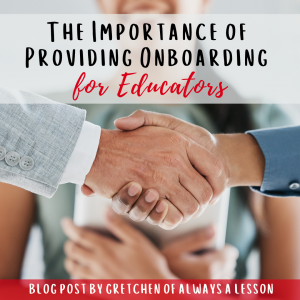The Importance of Providing Onboarding for Educators
Onboarding is essential for staff be able to do their role effectively. Onboarding establishes expectations and offers support. Dictionary.com defines onboarding as “the action or process of integrating a new employee into an organization or familiarizing a new customer or client with one’s products or services.”
 Onboarding should be the entry point from which all other training, support and development flow. Sadly, onboarding is an afterthought in many schools.
Onboarding should be the entry point from which all other training, support and development flow. Sadly, onboarding is an afterthought in many schools.
This post will describe who should receive onboarding and what should be included in the onboarding protocol. It will also include resources to support those designing and delivering onboarding to educators. Use the needs of your school to design customized onboarding systems.
Who Should Receive Onboarding
The following types of educators should receive onboarding prior to beginning their roles to ensure preparation and success:
- New Teacher
- New Hires
- Student Teachers
- Cooperating Teacher for Student Teachers
- Teacher Mentor
- Instructional Coach/PD Facilitator/Specialist
- Any Educator Changing Roles
What Onboarding Protocol Should Include for New Teachers
Onboarding support is essential for teachers who enter new buildings or roles. Some descriptors below include links to onboarding protocols. Download and customize them to fit your needs.
- New Teacher– New teachers need to bridge the gap from what they learned in college to how it applies in the exact environment they are teaching in. This could be from a school tour to curriculum digestion and everything in between.
- Rookie teachers at the elementary level can read “Elementary EDUC 101- What They Didn’t Teach you in College” as part of their onboarding homework.
- New Hire– Any new staff member entering the school building should receive onboarding that allows them to acclimate to the new environment. They will need to get a lay of the land prior to meeting with colleagues to discuss content.
- A protocol listed out ensures each new hire receives adequate training. Reference the New Hire Onboarding Checklist to get you started.
- Read the blog post entitled Onboarding: How to Support a New Hire at your School to understand all that a new hire onboarding protocol should include
- Student Teacher– When a student teacher enters your building, this is often their first experience with teaching on their own. It is a big moment full of emotions and anxiety. Aligning your onboarding with the college’s requirements will provide clarity and limit confusion and overwhelming feelings.
- Reference the Student Teacher Kit for ideas on what student teachers might need themselves in order to have a successful experience working with a cooperating teacher.
What Onboarding Protocol Should Include for New Roles
- Cooperating Teacher– An effective teacher isn’t always able to easily teach someone else how to teach. Additional information beyond tips for invitations and collaborations with another teacher in your classroom are necessary. Teaching how to lead their growth and development can be challenging. Onboarding will provide the roadmap for helping student teachers thrive under the care of cooperating teachers.
- Glance at the Hosting a Student Teacher Kit for ideas on what cooperating teachers should provide to their student teachers to ensure they are prepared for the experience.
- Mentor– Helping a colleague develop their craft can be tricky, just like the role of a cooperating teacher. You have to be a strong teacher but also be able to allow someone else to develop their own style AND be successful. Onboarding allows mentors to know how to provide support from a distance, unlike the cooperating teacher.
- Use the Teacher Mentor Kit to outline expectations for the mentor and mentee so that the partnership leads to growth in teacher performance.
- Coaches, Facilitators, Specialists, Etc. – Leading others to become stronger in their roles requires training. This makes sure that each person is operating in alignment with school goals, admin expectations, and understanding of teacher’s needs and wants.
- With over 300+ pages full of coaching support and forms to track how you’re working with teachers, the Instructional Coaching Bundle will allow you to be organized with a clear execution plan on supporting the growth of teachers.
- Any Educator Changing Roles– Onboarding role switchers will range from simple to complex depending on how similar their new role is to their old one. You might not have a clear protocol developed every time, but acknowledge the adjustment and provide support how you see fit so that they can be just as successful as before.
Next Steps for Onboarding
The following steps will allow you to implement your own successful onboarding protocols at your school site:
- Gather all of your resources
- Decide who in your building is eligible for onboarding
- Appoint teacher leaders to run the onboarding process (and train them as such)
- Include a meeting with yourself for everyone enrolled in the onboarding process
- Track your onboarding protocols and make adjustments as necessary
Now that you know who should receive onboarding and what the protocol should include, you’re on your way to ensuring educators are supported from the start.
If you are need of resources to help you become an even stronger teacher or coach, browse these printable and digital options. Check out my instructional coaching must-haves here. Don’t forget to catch up on other helpful blog posts as well. Snag my newest book, Always A Lesson: Teacher Essentials for Classroom and Career Success here!
GO BE GREAT!
What does your onboarding protocol look like?


 Get Edu-Tips, Freebies and grab your FREE Study Guide for Gretchen’s New Book!
Get Edu-Tips, Freebies and grab your FREE Study Guide for Gretchen’s New Book!